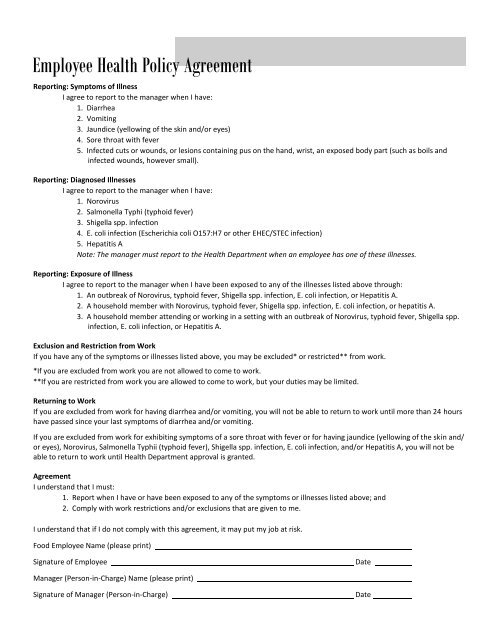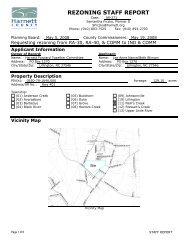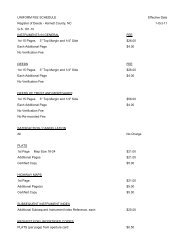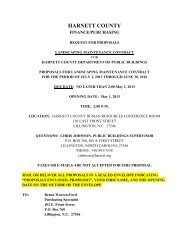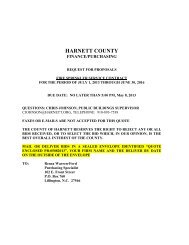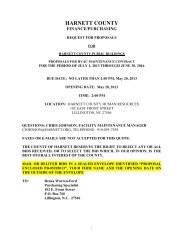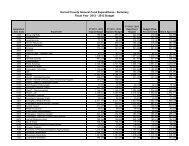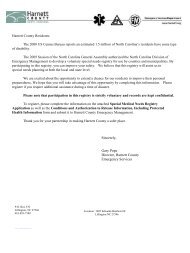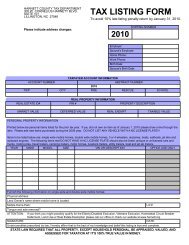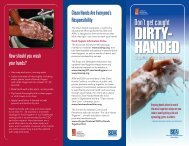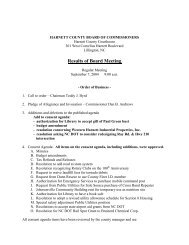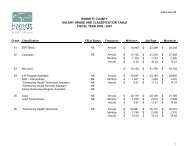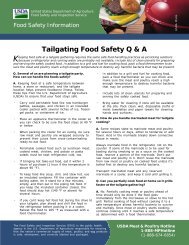Employee Health Policy Agreement - Stadium Food & Beverage
Employee Health Policy Agreement - Stadium Food & Beverage
Employee Health Policy Agreement - Stadium Food & Beverage
- No tags were found...
Create successful ePaper yourself
Turn your PDF publications into a flip-book with our unique Google optimized e-Paper software.
<strong>Employee</strong> <strong>Health</strong> <strong>Policy</strong> <strong>Agreement</strong>Reporting: Symptoms of IllnessI agree to report to the manager when I have:1. Diarrhea2. Vomiting3. Jaundice (yellowing of the skin and/or eyes)4. Sore throat with fever5. Infected cuts or wounds, or lesions containing pus on the hand, wrist, an exposed body part (such as boils andinfected wounds, however small).Reporting: Diagnosed IllnessesI agree to report to the manager when I have:1. Norovirus2. Salmonella Typhi (typhoid fever)3. Shigella spp. infection4. E. coli infection (Escherichia coli O157:H7 or other EHEC/STEC infection)5. Hepatitis ANote: The manager must report to the <strong>Health</strong> Department when an employee has one of these illnesses.Reporting: Exposure of IllnessI agree to report to the manager when I have been exposed to any of the illnesses listed above through:1. An outbreak of Norovirus, typhoid fever, Shigella spp. infection, E. coli infection, or Hepatitis A.2. A household member with Norovirus, typhoid fever, Shigella spp. infection, E. coli infection, or hepatitis A.3. A household member attending or working in a setting with an outbreak of Norovirus, typhoid fever, Shigella spp.infection, E. coli infection, or Hepatitis A.Exclusion and Restriction from WorkIf you have any of the symptoms or illnesses listed above, you may be excluded* or restricted** from work.*If you are excluded from work you are not allowed to come to work.**If you are restricted from work you are allowed to come to work, but your duties may be limited.Returning to WorkIf you are excluded from work for having diarrhea and/or vomiting, you will not be able to return to work until more than 24 hourshave passed since your last symptoms of diarrhea and/or vomiting.If you are excluded from work for exhibiting symptoms of a sore throat with fever or for having jaundice (yellowing of the skin and/or eyes), Norovirus, Salmonella Typhii (typhoid fever), Shigella spp. infection, E. coli infection, and/or Hepatitis A, you will not beable to return to work until <strong>Health</strong> Department approval is granted.<strong>Agreement</strong>I understand that I must:1. Report when I have or have been exposed to any of the symptoms or illnesses listed above; and2. Comply with work restrictions and/or exclusions that are given to me.I understand that if I do not comply with this agreement, it may put my job at risk.<strong>Food</strong> <strong>Employee</strong> Name (please print)Signature of <strong>Employee</strong>DateManager (Person-in-Charge) Name (please print)Signature of Manager (Person-in-Charge)Date
These are some of the Bacterium and Viruses spread from <strong>Food</strong> Handlers to <strong>Food</strong>E. ColiOverview: A bacterium that can produce a deadly toxin and causes an estimated 70,000 cases of foodborneillnesses each year in the U.S.Sources: Meat, especially undercooked or raw hamburger, produce and raw milk.Incubation period: 2-10 daysSymptoms: Severe diarrhea, cramping, dehydrationPrevention: Cook implicated food to 155F, wash hands properly and frequently, correctly wash rinse andsanitize food contact surfaces.Ways of Prevention1. Handwashing is the MOSTCRITICAL control step inprevention of diseaseInvest 20 seconds to followthese 6 simple steps:1. Wet your hands and armswith warm running water.2. Apply soap and bring to agood lather.3. Scrub hands and armsvigorously for 10 to 15seconds (clean under nailsand between fingers).4. Rinse hands and armsthoroughly under runningwater.5. Dry hands and arms with asingle-use paper towel orwarm-air hand dryer.6. Use the towel to turn offfaucets and open doorhandles so you don’t recontaminateyour hands2. Don’t go to work when youare sick3. No bare hand contact withready-to-eat foods.ShigellaOverview: Shigella is a bacterium that causes an estimated 450,000 cases of diarrhea illnesses each year.Poor hygiene causes Shigella to be easily passed from person to person.Sources: Salad, milk, and dairy products, and unclean water.Incubation period: 1-7 daysSymptoms: Diarrhea, stomach cramps, fever, chills and dehydrationPrevention: Wash hands properly and frequently, especially after using the restroom, wash vegetablesthoroughly.SalmonellaOverview: Salmonella is a bacterium responsible for millions of cases of foodborne illnesses a year. Elderly,infants and individuals with impaired immune systems are at risk to severe illness and death can occur if theperson is not treated promptly with antibiotics.Sources: raw and undercooked eggs, undercooked poultry and meat, dairy products, seafood, fruits andvegetablesIncubation period: 5-72 hours (up to 16 days has been documented for low doses)Symptoms: Nausea, vomiting, cramps, and feverPrevention: Cook all food to proper temperatures, chill food rapidly, and eliminate sources of crosscontamination (i.e. proper meat storage, proper wash, rinse, and sanitize procedure)Hepatitis AOverview: Hepatitis A is a liver disease caused by the Hepatitis A virus. Hepatitis A can affect anyone. In theUnited States, Hepatitis A can occur in situations ranging from isolated cases of disease to widespreadepidemics.Incubation period: 15-50 daysSymptoms: Jaundice, nausea, diarrhea, fever, fatigue, loss of appetite, crampsPrevention: Wash hands properly and frequently, especially after using the restroom.NorovirusOverview: This virus is the leading cause of diarrhea in the United States. Any food can be contaminated withnorovirus if handled by someone who is infected with the virus. This virus is highly infectious.Incubation period: 6-48 hoursSymptoms: Nausea, vomiting, diarrhea, and crampsPrevention: Wash hands properly and frequently, especially after using the restroom: obtain food from areputable food source: and wash vegetables thoroughly.Staph (Staphylococcus aureus)Overview: Staph food poisoning is a gastrointestinal illness. It is caused by eating foods contaminated withtoxins produced by Staphylococcus aureus. Staph can be found on the skin, in the mouth, throat, and nose ofmany employees. The hands of employees can be contaminated by touching their nose, infected cuts or otherbody parts. Staph produces toxins that are extremely heat stable and are not inactivated by normal reheatingtemperatures. It is important that food contamination be minimized.Incubation period: Staph toxins are fast acting, sometimes causing illness in as little as 30 minutes after eatingcontaminated foods, but symptoms usually develop within one to six hours.Sources: Ready-to-eat foods touched by bare hands. <strong>Food</strong>s at highest risk of producing toxins are those thatare made by hand and require no cooking.Symptoms: Patients typically experience several of the following: nausea, vomiting, stomach cramps, anddiarrhea. The illness lasts one day to three days. In a small minority of patients the illness may be more severe.Prevention: No bare hand contact with ready-to-eat foods. Wash hands properly. Do not prepare food if youhave a nose or eye infection. Do not prepare or serve food for others if you have wounds or skin infections onyour hands or wrists. If food is to be stored longer than two hours, keep hot foods hot (over 135°F) and coldfoods cold (41°F or under). Properly cool all foods.


